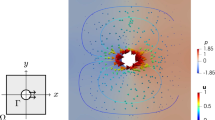Abstract
Numerous numerical and experimental evidence suggest that shear banding behavior looks like first-order phase transitions. In this paper, we demonstrate that this correspondence is actually established in the so-called non-local diffusive Johnson-Segalman model (the DJS model), a typical mechanical constitutive model that has been widely used for describing shear banding phenomena. In the neighborhood of the critical point, we apply the reduction procedure based on the center manifold theory to the governing equations of the DJS model. As a result, we obtain a time evolution equation of the flow field that is equivalent to the time-dependent Ginzburg-Landau (TDGL) equations for modeling thermodynamic first-order phase transitions. This result, for the first time, provides a mathematical proof that there is an analogy between the mechanical instability and thermodynamic phase transition at least in the vicinity of the critical point of the shear banding of DJS model. Within this framework, we can clearly distinguish the metastable branch in the stress-strain rate curve around the shear banding region from the globally stable branch. A simple extension of this analysis to a class of more general constitutive models is also discussed. Numerical simulations for the original DJS model and the reduced TDGL equation is performed to confirm the range of validity of our reduction theory.
Similar content being viewed by others
References
H. Rehage, H. Hoffmann, Mol. Phys. 74, 933 (1991)
M.E. Cates, M. Fielding, Adv. Phys. 55, 799 (2006)
N.A. Spenley, M.E. Cates, T.C. McLeish, Phys. Rev. Lett. 71, 939 (1993)
C. Grand, J. Arrault, M.E. Cates,, J. Phys. II 7, 1071 (1997)
J.P. Decruppe, R. Cressely, R. Makhloufi, E. Cappelaere, Colloid Polym. Sci. 273, 346 (1995)
R.W. Mair, P.T. Callaghan, Europhys. Lett. 36, 719 (1996)
S. Lerouge, J.P. Decruppe, C. Humbert, Phys. Rev. Lett. 81, 5457 (1998)
J.B. Salmon, A. Colin, S. Manneville, Phys. Rev. Lett. 90, 228303 (2003)
X.F. Yuan, Europhys. Lett. 46, 542 (1999)
C.Y.D. Lu, P.D. Olmsted, R.C. Ball, Phys. Rev. Lett. 84, 642 (2000)
S.M. Fielding, Phys. Rev. Lett. 95, 134501 (2005)
J.K.G. Dhont, Phys. Rev. E 60, 4534 (1999)
M. Doi, A. Onuki, J. Phys. II 2, 1631 (1992)
X.F. Yuan, L. Jupp, Europhys. Lett. 60, 691 (2002)
S.M. Fielding, P.D. Olmsted, Phys. Rev. Lett. 90, 224501 (2003)
H. Mori, Y. Kuramoto, Dissipative Structures and Chaos (Springer-Verlag, Berlin, 1998)
H. Haken, Advanced Synergetics: Instability Hierarchies of Self-Organizing Systems and Devices (Springer-Verlag, Berlin, 1983)
M. Johnson, D. Segalman, J. Non-Newtonian Fluid Mech. 2, 255 (1977)
A.W. El-Kareh, L.G. Leal, J. Non-Newtonian Fluid Mech. 33, 257 (1989)
P.D. Olmsted, O. Radulescu, C.Y.D. Lu, J. Rheol. 44, 257 (2000)
D.S. Malkus, J.A. Nohel, B.J. Plohr, J. Comput. Phys. 87, 464 (1990)
O. Radulescu, P.D. Olmsted, J.P. Decruppe, S. Lerouge, J.F. Berret, G. Porte, Europhys. Lett. 62, 230 (2003)
J. Yerushalmi, S. Katz, R. Shinnar, Chem. Eng. Sci. 25, 1891 (1970)
P. Espanol, X.F. Yuan, R.C. Ball, J. Non-Newtonian Fluid Mech. 65, 93 (1996)
L.D. Landau, E.M. Lifshitz, Statistical Physics (Pergamon Press, Oxford, 1980)
K. Kawasaki, M. Suzuki, A. Onuki, Formation, Dynamics and Statistics of Pattern (World Scientific, Singapore, 1990)
K. Kawasaki, T. Koga, Prog. Theor. Phys. Suppl. 99, 339 (1989)
H. Hayakawa, T. Koga, J. Phys. Soc. Jpn. 59, 3542 (1990)
S. Noguchi, T. Ohta, J. Phys. Soc. Jpn. 72, 1315 (2003)
O. Radulescu, P.D. Olmsted, J. Non-Newtonian Fluid Mech. 91, 143 (2000)
J.M. Adams, P.D. Olmsted, Phys. Rev. Lett. 102, 067801 (2009)
P.D. Olmsted, Rheol. Acta 47, 283 (2008)
A.E. Likhtman, R.S. Graham, J. Non-Newtonian Fluid Mech. 114, 1 (2003)
Author information
Authors and Affiliations
Corresponding author
Rights and permissions
About this article
Cite this article
Sato, K., Yuan, X.F. & Kawakatsu, T. Why does shear banding behave like first-order phase transitions? Derivation of a potential from a mechanical constitutive model. Eur. Phys. J. E 31, 135–144 (2010). https://doi.org/10.1140/epje/i2010-10557-7
Received:
Revised:
Published:
Issue Date:
DOI: https://doi.org/10.1140/epje/i2010-10557-7



